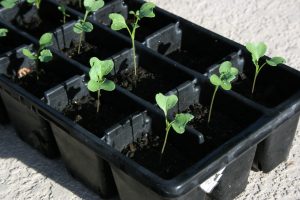
It was volunteering in her children’s Montessori school garden that gave rise to her new series Wild Tales & Garden Thrills, stories bursting with the real-life experiences of young gardeners. Children see the world from a totally different perspective than adults and Venetta knows their adventures will surely inspire a new generation to get outside,
and get digging.
Ready to start a vegetable garden, but not sure where to begin?
Well then, you’ve come to the right place! Follow along step-by-step as I show you how to begin and maintain a vegetable garden. First on the list of things to do: choose a list of delectable fruits and vegetables you would love to grow. Think positive here, and focus on what you like to eat, NOT what you think you can grow. Be sure these are all things you will eat. While the variety and color a bunch of different vegetables may add to your garden’s appearance, they’ll ruin the affect when left withering on the vine (because no one cared enough to harvest them). It happens. You’re in the garden, short on time, what are you going to harvest? Your favorites, that’s what, so choose your seeds wisely.

Next, you must determine a spot for this wonderful new adventure of yours, and believe me when I say adventure. From bees to worms and wonderful produce, there’s never a dull moment in a garden. As to location, remember: most fruits and vegetables need a solid 4 hours of sunshine with a reliable water source nearby. Once you’ve chosen a location, be mindful of the soil. Plants prefer soft soil, with good moisture retention made from rich organic matter. (Oh, brother. Is that all?) Most will need a depth of approximately 8-12” to allow for strong root growth. You’ll also need to decide if you’re planting “in-ground” or “above-ground.” Raised beds are lovely and can ease the pain in your back, but they require construction. In-ground gardens require a bit of construction, too, in the form of “grass removal” and “bed-building.”
Finally, consider mulching around your plants. It will keep the weeds in check and eventually break down to become a source of nutrition for your plants. Use pine mulch for acid-loving plants like berries and potatoes, though store-bought plastic liners will also suffice. While we’re talking soil, let’s discuss compost. Whether you use a bin on the patio, or a pile in your backyard, consider the value of tossing your kitchen leftovers and dead leaves into a pile and letting Mother Nature create the most amazing organic matter for you. It’s recycling at its best!
Another added benefit? Compost tea does amazing things for plant growth. Simply fill a bucket 1/3 full of finished compost, 2/3 water. Let the mixture steep for 3-4 days, stirring once a day. Strain the mixture through a porous fabric (cheesecloth, burlap, or netting) into another bucket. Add the remaining solids to your garden or compost bin. Dilute the strained liquid with water so it’s the color of weak tea. A ratio of 10:1 works, water:compost liquid. Use compost tea immediately for best absorption by pouring into the soil around plants. You can also use it as a spray by adding 1/8 teaspoon of vegetable oil or mild dish-washing liquid per gallon of compost tea.

